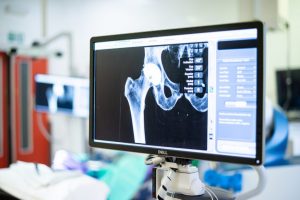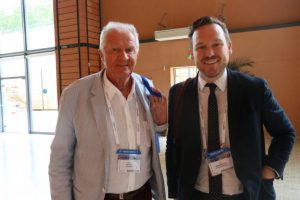The team at ORI continue to pioneer the research in this area, with contributions to guidelines, textbooks, conference posters and implementation.
This year, Professor Robert Middleton and Professor Tom Wainwright co-authored the ERAS Society guidelines for hip and knee replacement surgery, which is currently one of the most-read articles in Acta Orthopaedica, with over 20,000 reads.
Tom Wainwright also recently collaborated with Professor Henrik Kehlet from Denmark, who first initiated ERAS, also known as “fast-track surgery” to colorectal procedures in the 1990s. Their publication, entitled: “Fast-track hip and knee arthroplasty – have we reached the goal?” discusses the remaining challenges with implementation of ERAS pathways to hip and knee replacement, in order to achieve the goal of pain and risk free surgery. The ORI team were also invited to contribute to the textbook, “ERAS – A Complete Guide to Optimizing Outcomes“, and published two chapters on early ambulation and physiotherapy after surgery, and orthopaedic surgery in ERAS.
ORI has also extended its research on ERAS to other surgical procedures, collaborating with international and local surgeons, looking at ERAS in spinal procedures, total ankle replacement, shoulder surgery and hip fracture. Externally, Tom Wainwright holds a position as orthopaedic lead at the ERAS Society and director and treasurer at ERAS UK. These organisations aim to improve patient recovery after surgery by promoting knowledge, understanding and research regarding optimal outcomes.
Please see below for a selection of publications that ORI have been involved in:
May 2021 – The Spine Journal
“This multidisciplinary consensus review summarises the literature and proposes recommendations for the perioperative care of patients undergoing lumbar fusion surgery with an ERAS programme.”
Rehabilitation strategies for optimisation of functional recovery after major joint replacement
December 2018 – Journal of Experimental Orthopaedics
“The goal of this commentary is to summarise recent evidence for the efficacy of different peri-operative exercise-based interventions to enhance recovery after total hip and knee arthroplasty, and to propose new strategies to further enhance post-operative recovery.
Older patients have the most to gain from orthopaedic enhanced recovery programmes
September 2014 – Age and Ageing
“This paper aimed to investigate the potential benefits of the enhanced recovery pathway in patients undergoing hip or knee joint replacement surgery over the age of 85 years. In all patients, median length of stay was reduced. This study not only shows that successful fast track rehabilitation can be achieved in the very elderly population undergoing elective joint replacement surgery, but that it is this cohort of vulnerable patients who have the most to gain from such multidisciplinary recovery programmes.”
March 2014 – The Annals of the Royal College of Surgeons of England
“The aim of this paper was to systematically review the literature on the use of patient generated information in orthopaedic ERAS across the whole perioperative pathway. Overall, ERAS did not compromise patient satisfaction and patients prefer a shorter length of hospital stay.”
What is the role of minimally invasive surgery in a fast track hip and knee replacement pathway?
April 2012 – The Annals of the Royal College of Surgeons of England
“This paper evaluates the literature and discusses whether performing minimally invasive hip and knee replacement surgery (MIS) over conventional surgical techniques offers advantages in a fast track hip and knee pathway. The paper found that the reported improvements in recovery brought about by MIS must be considered multifactorial. In combination with improved clinical pathways, MIS can be associated with quicker recovery and shorter length of hospital stay. There is insufficient evidence to indicate that surgical technique alone makes a significant difference to recovery or reduces soft tissue trauma.”
An orthopaedic enhanced recovery
June 2010 – Current Anaesthesia & Critical Care
“This article briefly outlines what is meant by an enhanced recovery pathway (ERP) and outline the central characteristics and features which make up an ERP. The procedural details and results of an orthopaedic ERP which has been used in 2391 consecutive hip and knee joint replacement patients at a NHS district general hospital within the United Kingdom will then be outlined. The results of this unit illustrate that when a standardised, multi-disciplinary pathway is implemented and managed correctly, dramatic reductions to length of stay can be achieved. In combination, high levels of both staff and patient satisfaction are achieved along with good clinical outcomes. It is proposed that if such ways of working are implemented in other hospitals, major economic and capacity savings could be realised at the same time as improving patient care.”






